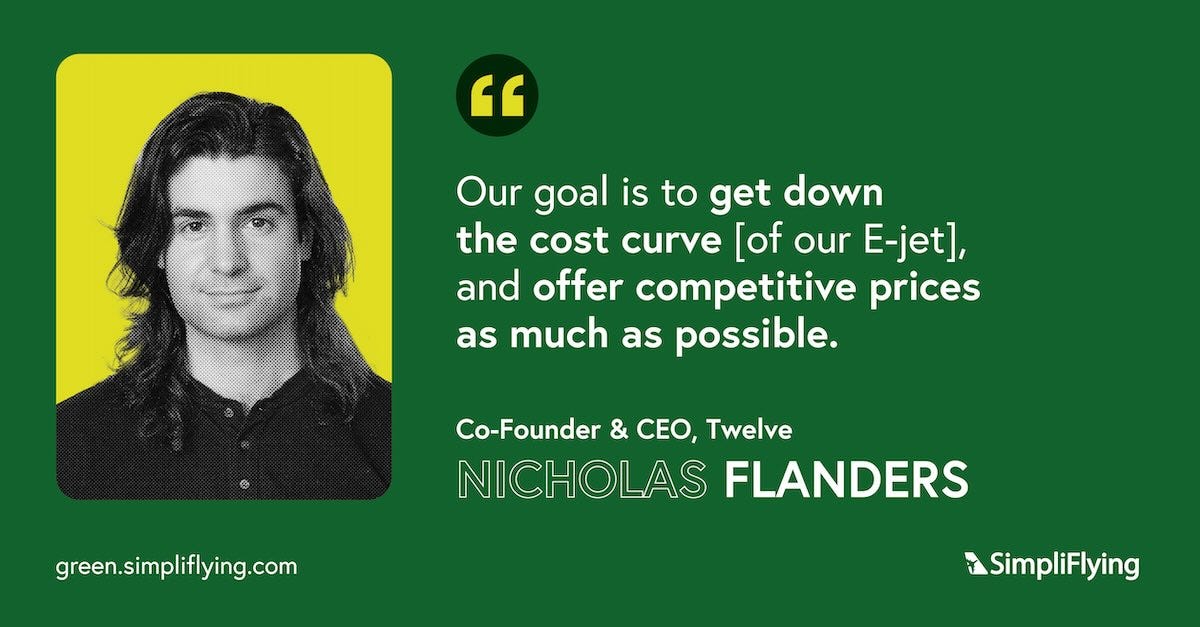In this episode of our ‘Sustainability in the Air’ podcast, Nicholas Flanders, Co-Founder and CEO of carbon transformation company Twelve, speaks with SimpliFlying CEO Shashank Nigam about the crucial role of clean technology in addressing environmental challenges, particularly in hard-to-decarbonise sectors like aviation.
Here are the key highlights of the conversation:
Twelve’s carbon transformation technology and its applications (2:01)
Twelve’s fuel production and partnerships (7:20)
Challenges with SAF and green electricity (12:35)
Bringing down the cost curve (19:21)
The significant role of offtake agreements in promoting SAF (28:59)
Rapid Fire! (30:36)
Keep reading for a quick overview of the episode.
Why Twelve’s carbon transformation process matters
The versatility of Twelve’s technology is underscored by their ability to transform CO2 into a wide range of products, ranging from sunglasses and washing detergents to car parts.
Called carbon transformation, the process uses CO2 as a feedstock to displace fossil fuels. Through electrochemical technology, CO2, water and renewable energy are converted into hydrocarbons with only water and oxygen as outputs. These hydrocarbons serve as building blocks that can be used to make the same chemicals, materials, and fuels from CO2 that are conventionally made from fossil fuels.
By substituting fossil fuel-derived building blocks with those made from CO2 and water, Twelve aims to create a circular economy model. This could not only mitigate carbon emissions but also challenge the traditional reliance on fossil fuels for manufacturing a vast array of consumer goods.
5 ways Twelve is transforming aviation
1. Innovative approach to decarbonising aviation
The aviation sector is difficult to decarbonise. With new technologies like electric and hydrogen planes still in their infancy, sustainable aviation fuel (SAF) remains the most promising solution at hand.
Twelve’s innovative SAF, called E-Jet®, is made entirely from CO2 and water using their carbon transformation technology. This Power-to-Liquids SAF has a much lower carbon intensity score and up to 90% lower lifecycle emissions than conventional fuel.
Moreover, E-jet is ASTM compliant, which makes it eligible for use as a drop-in fuel, up to a 50-50 blend in any existing jet engine aircraft, says Flanders.
2. Challenges and opportunities in scaling SAF production
There is a dire need to expand SAF production to meet aviation’s flying needs.
Flanders notes that producing even a billion gallons of SAF annually would only satisfy a fraction of the actual requirement. This underscores the daunting task of scaling up SAF production to have a meaningful impact on the aviation industry's carbon footprint.
“Even if we were making a billion gallons a year, that would only be 1% of global aviation fuel demand.”
However, Flanders also identifies significant opportunities in this endeavour. The strategic use of green electricity and the development of efficient carbon transformation technologies present avenues for making SAF production more sustainable and cost-effective.
3. The role of offtake agreements
Flanders emphasises that for a significant shift towards sustainability, airlines and corporate partners need to alter their traditional fuel purchasing practices.
Instead of the short-term contracts typical for fossil jet fuel, the industry needs to embrace long-term offtake agreements. Such commitments are pivotal for accelerating SAF growth, as they signal a strong market demand, encouraging further investment and innovation in the sector.
“What’s important for airlines and corporate partners to really accelerate the adoption of sustainable aviation fuel is to make purchasing in a different way than they buy fuel today.”
Despite scepticism about the tangible impact of these agreements, especially concerns about the lack of immediate financial commitment from airlines, Flanders clarifies that the efficacy of an offtake agreement lies in its specificity and binding nature. He asserts that many airlines are indeed making substantial, firm commitments to SAF, integrating these into their financial strategies with a clear expectation of receiving and utilising sustainable fuel.
4. Getting down costs
Twelve has strategically focused on reducing the cost of E-jet to make it competitive with traditional fossil fuels. Flanders points out that the US offers some incentives based on the carbon intensity (CI) score of the fuel, with lower CI scores attracting better incentives. With Twelve’s technology achieving a CI reduction of over 90%, it positions the company advantageously to benefit from such incentives.
However, Flanders emphasises the ultimate goal of making Twelve's product as cost-effective as possible, aiming to offer a competitive price that aligns with the market’s shift towards evaluating the cost per tonne of CO2 reduced.
Initially, Twelve’s SAF will be more expensive than fossil Jet A fuel due to the early stages of scaling and the novelty of the technology. Yet, Flanders is confident that with scale Twelve can achieve cost competitiveness with both alternative SAF pathways and fossil fuels.
Flanders also discusses Twelve’s strategy to supply international airline partners with SAF for flights departing from the US. This approach allows Twelve to leverage its US-based production facilities in the short term, while planning for future expansion to locations worldwide where green electricity costs are low, such as the Middle East, Australia, and Chile. This global expansion strategy is integral to Twelve's mission to make e-fuels accessible and affordable, contributing to the broader adoption of SAF and the transition towards more sustainable aviation practices.
5. Strategic partnerships
Twelve’s strategic partnerships have been instrumental in their success. By collaborating with entities like the Air Force and companies such as Mercedes Benz for the creation of the world’s first car parts from CO2, Twelve has not only demonstrated the practical applications of their carbon transformation technology but also leveraged the broad market interest in sustainability. These partnerships serve as powerful endorsements of Twelve’s vision, providing crucial early support and validation.
Twelve also has an agreement with Alaska Airlines and Microsoft to advance the scalability and use of the Twelve’s E-Jet. The companies will also work toward a demonstration flight using E-Jet and supply the fuel to address some of Microsoft’s business travel on Alaska.
‘Sustainability in the Air’ is the world’s leading podcast dedicated to sustainable aviation. Through in-depth conversations with top aviation leaders, we break through the clutter and provide a clear roadmap for a net-zero future.













